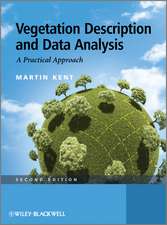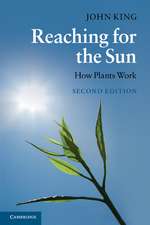Photosynthesis: Structures, Mechanisms, and Applications
Editat de Harvey J.M. Hou, Mohammad Mahdi Najafpour, Gary F. Moore, Suleyman I. Allakhverdieven Limba Engleză Hardback – 26 mai 2017
| Toate formatele și edițiile | Preț | Express |
|---|---|---|
| Paperback (1) | 1206.18 lei 38-44 zile | |
| Springer International Publishing – 29 iul 2018 | 1206.18 lei 38-44 zile | |
| Hardback (1) | 1229.16 lei 38-44 zile | |
| Springer International Publishing – 26 mai 2017 | 1229.16 lei 38-44 zile |
Preț: 1229.16 lei
Preț vechi: 1617.32 lei
-24% Nou
Puncte Express: 1844
Preț estimativ în valută:
235.19€ • 246.23$ • 194.61£
235.19€ • 246.23$ • 194.61£
Carte tipărită la comandă
Livrare economică 01-07 aprilie
Preluare comenzi: 021 569.72.76
Specificații
ISBN-13: 9783319488714
ISBN-10: 3319488716
Pagini: 600
Ilustrații: XXI, 417 p. 180 illus., 144 illus. in color.
Dimensiuni: 178 x 254 mm
Greutate: 1.12 kg
Ediția:1st ed. 2017
Editura: Springer International Publishing
Colecția Springer
Locul publicării:Cham, Switzerland
ISBN-10: 3319488716
Pagini: 600
Ilustrații: XXI, 417 p. 180 illus., 144 illus. in color.
Dimensiuni: 178 x 254 mm
Greutate: 1.12 kg
Ediția:1st ed. 2017
Editura: Springer International Publishing
Colecția Springer
Locul publicării:Cham, Switzerland
Cuprins
Foreword.- Preface.- 1. Photosynthesis: Natural Nanomachines Toward Energy and Food Production.- 2. Structure and Function of the Reaction Center - Light Harvesting 1 Core Complexes from the Purple Photosynthetic Bacteria.- 3. Recombinant Light-harvesting Complexes: Views and Perspectives.- 4. Alternative Electron Acceptors for Photosystem II.- 5. Chloride Requirement for Oxygen Evolution by Photosystem II as Explored by Enzyme Kinetics and Electron Paramagnetic Resonance (EPR) Spectroscopy.- 6. Vectorial Charge Transfer Reactions in Photosystem II.- 7. Function and Structure of Cyanobacterial Photosystem I.- 8. How Light-Harvesting and Energy-Transfer Processes are Modified under Different Light Conditions: Studies by Time-Resolved Fluorescence Spectroscopy.- 9. Interaction of Glycine Betaine and Plant Hormones: Protection of the Photosynthetic Apparatus during Abiotic Stress.- 10. Photosynthetic Responses Under Harmful and Changing Environment: Practical Aspects in Crop Research.- 11. Effects of Environmental Pollutants Polycyclic Aromatic Hydrocarbons (PAH) on Photosynthetic Processes.- 12. Chlorophyll Fluorescence for High-Throughput Screening of Plants during Abiotic Stress, Aging, and Genetic Perturbation.- 13. Adaptation to Low Temperature in a Photoautotrophic Antarctic Psychrophile, Chlamydomonas sp. UWO 241.- 14. Nitric Oxide Mediated Effects on Chloroplasts.- 15. Nanostructured Mn Oxide/Carboxylic Acid or Amine Functionalized Carbon Nanotubes as Water-oxidizing Composites in Artificial Photosynthesis.- 16. Self-healing in Nano-sized Manganese-based Water-oxidizing Catalysts.- 17. A Robust Photosystem II Mimic: Manganese/Tungsten Oxide Nanostructures for Water-splitting.- 18. Electron Paramagnetic Resonance Spectroscopy of Artificial Photosynthetic Complexes.- 19. Artificial Photosynthesis based on 1,10-Phenanthroline Complexes.- 20. Concluding Remarks and Future Perspectives: Looking Back and Moving Forward.- Index.
Recenzii
“This volume comprises a heavy dose (seven chapters worth) of photosynthetic light reactions, a good description of chlorophyll fluorescence for the screening and selection of highly efficient plants, five chapters on artificial photosynthesis and biological responses to various stressors, plus an introduction and conclusion. … Summing Up: Recommended.” (L. C. Davis, Choice, Vol. 55 (5), January, 2018)
Notă biografică
Harvey J.M. Hou, born in 1962 in China, is a Professor in the Department of Physical Sciences at Alabama State University, Montgomery, Alabama, USA. He received his B.Sc. in Physical Chemistry in 1984 from Wuhan University, and completed his Ph.D. in Analytical Chemistry in 1993 at Peking University (Beijing, China) with Xiaoxia Gao. He had his postdoctoral training at Chinese Academy of Sciences with Peisung Tang and Tingyun Kuang, at Iowa State University with Parag Chitnis, and at the Rockefeller University with David Mauzerall. Since 1995, he has served as a faculty member at the Chinese Academy of Sciences, Gonzaga University, the University of Massachusetts at Dartmouth, and the Alabama State University. He began his research career in photosynthesis in 1993, working on photosystem II (PS II). In 1996, he visited the laboratory of Jacque Breton in France and studied the orientation of pigments in PS II. In the laboratory of Parag Chitnis, he examined the organization of PS I.Working with David Mauzerall, he systematically investigated the thermodynamics of electron transfer reactions in photosynthesis using pulsed photoacoustics. His work has uncovered a significant entropy change of reaction in PS I; further, he has demonstrated that the entropy change in PS I is dramatically different from that in PS II. Since he established his laboratory in 2002, he has maintained his long-term collaboration with David Mauzerall on the thermodynamics in cyanobacterial PS I and in Heliobacteria. In 2006, he began collaboration with Gary Brudvig at Yale University and Dunwei Wang at Boston College on artificial photosynthesis, and has developed a manganese/semiconductor system for solar energy storage. His research group has also investigated the responses of cyanobacteria and cranberry plants to environment. He co-chaired a symposium at the 15th International Congress of Photosynthesis Research, chaired the 28th Annual Eastern Regional Photosynthesis Conference, and he co-organized the 38th Annual Midwest/Southeast Photosynthesis Meeting.
Textul de pe ultima copertă
To address the environmental, socioeconomic, and geopolitical issues associated with increasing global human energy consumption, technologies for utilizing renewable carbon-free or carbon-neutral energy sources must be identified and developed. Among renewable sources, solar energy is quite promising as it alone is sufficient to meet global human demands well into the foreseeable future. However, it is diffuse and diurnal. Thus effective strategies must be developed for its capture, conversion and storage. In this context, photosynthesis provides a paradigm for large-scale deployment. Photosynthesis occurs in plants, algae, and cyanobacteria and has evolved over 3 billion years. The process of photosynthesis currently produces more than 100 billion tons of dry biomass annually, which equates to a global energy storage rate of ~100 TW. Recently, detailed structural information on the natural photosynthetic systems has been acquired at the molecular level, providing a foundation for comprehensive functional studies of the photosynthetic process. Likewise, sophisticated spectroscopic techniques have revealed important mechanistic details. Such accomplishments have made it possible for scientists and engineers to construct artificial systems for solar energy transduction that are inspired by their biological counterparts. The book contains articles written by experts and world leaders in their respective fields and summarizes the exciting breakthroughs toward understanding the structures and mechanisms of the photosynthetic apparatus as well as efforts toward developing revolutionary new energy conversion technologies. The topics/chapters will be organized in terms of the natural sequence of events occurring in the process of photosynthesis, while keeping a higher-order organization of structure and mechanism as well as the notion that biology can inspire human technologies. For example, the topic of light harvesting, will be followed by charge separation at reaction centers, followed by charge stabilization, followed by chemical reactions, followed by protection mechanisms, followed by other more specialized topics and finally ending with artificial systems and looking forward. The book includes and integrates topics on the structures and mechanisms of photosynthesis, and provides relevant information on applications to bioenergy and solar energy transduction.
Caracteristici
Covers several very new topics on photosynthesis, all under one volume Describes recent structures and mechanisms of natural photosynthetic systems including light-harvesting complexes as well as type-I and type-II reaction centers Includes detailed structures and mechanisms of artificial photosynthetic systems









